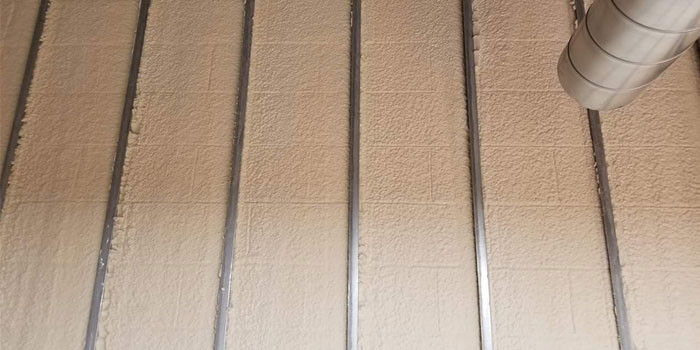Homes for Heroes


SUMMER ISSUE 2019 (Spray Foam Magazine) – “The Government of Canada recognizes the pressing need to prevent and reduce homelessness in Canada. Investing in Canada’s communities is not only about creating good jobs and encouraging economic growth, but it is also about building stronger communities and empowering all Canadians to build better lives for themselves.” — The Honorable Jean-Yves Duclos, Minister of Families, Children and Social Development
The United States of America has long recognized their homeless situation with the Department of Housing and Urban Development recording just under 40,000 homeless in 2018. Between 2017 and 2018, there was a promising 5.4% decrease in the estimated number of homeless veterans nationwide. This reduction may be due to the help of organizations like Chatham Savannah Authority for the Homeless who are currently building “tiny homes.” These homes help rehome veterans and are designed with community in mind helping vets integrate back into society.
The Spray Foam Magazine team heard about a similar project underway in Canada and decided to investigate. Chatting to our friends in the north, we wanted details about these compact homes and how spray foam was the insulation of choice.
The Homes for Heroes Foundation’s first tiny homes village project will be completed by October 2019 and it will consist of 18 homes.
The Canadian government only highlighted the issue of homelessness as late as 2013, with strategies implemented in 2014 to combat the growing problem. As part of the National Housing Strategies budget in 2017, an investment of $2.2 billion over the course of 10 years was injected into tackling homelessness through an expanded and redesigned Homelessness Partnering Strategy.
Prior to this period, the numbers of veterans living on the streets of Canada were unclear, with figures recorded in the low hundreds but are now known to be in the thousands. A majority of veterans find themselves homeless due to a number of issues, such as family issues, drug or alcohol abuse, and mental health issues, including war trauma or post traumatic stress.
The Veterans Emergency Transition Services (VETS Canada) is a national, volunteer driven, nonprofit corporation helping veterans who are in crisis and may be at risk of becoming homeless or are homeless. They identify organizations that will help rehome the veteran. One such organization is Homes for Heroes Foundation. They provide homes, a community, and a support structure all designed to meet individual needs, and they create a sense of place and belonging. This bridges the gap for the veteran to find a home and integrate back into civilization.
Homes for Heroes Foundation’s First Tiny Homes Village project will be completed by October 2019, and it will consist of 18 homes. The foundation hopes to eventually expand these homes across Canada. The 275 square foot houses, which are situated in Calgary, Canada are a joint effort between Homes for Heroes Foundation, ATCO builders and The Mustard Seed. Homes for Heroes president and co-founder David Howard says, “There are at least 2,600 homeless veterans in Canada, but we believe the numbers to be a lot higher due to many of them not self-identifying. These are not just homes we are building, they are a community. There is help and support which will help stop the situation and the cycle that many of these veterans find themselves in.”
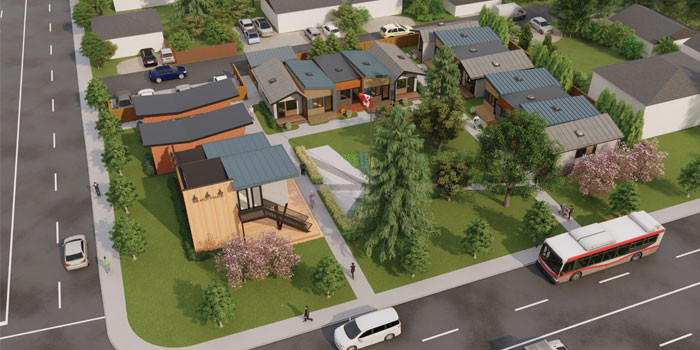
The Mustard Seed is a charitable organization which builds communities, grows hope, and supports change for people who are experiencing poverty and homelessness. Also based in Calgary and Edmonton, they provide basic services such as meals, clothing and shelter, as well as long-term solutions and support services like housing, employment, health & wellness, and spiritual guidance. They are working with the Homes for Heroes Foundation to help select suitable candidates to move into the villages and provide them with social support once they’re in. The residents will then pay a low, subsidized rent.
Boris Lesar, Director of Clinical Operations and Programs at The Mustard Seed, states, “The results of various studies help demonstrate how vulnerable many veterans can be following their return from deployment. Along with veterans who have mental health or substance abuse problems, veterans with few financial assets or those who don’t have family members they can turn to for support may find themselves on the street. Homes for Heroes is part of the solution in assisting veterans find a place where healing and quality of life can begin to be built.
The homes may be small, but they are perfectly formed, with a fully equipped kitchen, three-piece bathroom, and a living room that doubles as a bedroom with a Murphy-bed.
Shawn Talbot, Senior Builder at ATCO explains, “ATCO has a reputation for building well-structured modular homes. The Homes for Heroes are modular with a wood frame. They specified that they wanted the homes to exceed the environmental code by 10% and choosing spray foam as the insulation, as well as other factors, helped achieve this.”
The amount of care, consideration, and passion that has gone into this project is heartfelt. It’s all in the details with the village having a resource center, community gardens, and a memorial garden for soldiers who lost their lives in Afghanistan. Each home is being named after after a solider lost while serving Canada. From its unique design to the choice of insulation, every step has been planned to precision.
Curt Janzen and his brother-in-law, Kevin Boschee, launched Beyond Foam Insulation Ltd after realizing there was a gap in the market, and they would be the ones who could fill it. Kevin was a registered social worker working with youth who had social and emotional issues. After numerous years of working in the social services field, he needed a change of vocation. Kevin had almost completed his RCMP application and was close to starting his training. He decided that staying in Calgary and starting an insulation business was a better choice for his family.
Curt and Kevin started the business working out of Curt’s garage and that’s how Beyond Foam made its start in Calgary. The first year Curt and Kevin worked hard at learning both the art and the science of installing foam, while defining their roles in the company. The company soon grew and the men made not only a wide array of connections, for example ATCO, but also a reputation for producing quality work.
Curt Janzen (left) and his business partner Kevin Boschee (right) from Beyond Foam chose this job to help give back to those heroes that sacrificed for their country.
Janzen describes how this particular project came into play, “I worked with the ATCO builders to write the spec on the insulation. They are aware of the spray foam benefits like the fact that its air tight, acts as a vapor barrier and a high R-value.”
The builder needed an insulation that could ensure these units were warm in the colder climates. A majority of the spray foam was installed under the floor with the insulation having to be lightweight because the homes are portable. The R40 two-pound foam will secure the building and will not shift or gap in transit.
Beyond Foam had a three-man crew working this job because the builds were small and they managed to complete the first phase of the village insulation in a day. The crew wore safety gear including, Tyvek suits, Nytril gloves and boots. They used a dual spray rig with a Graco H-40 Hydraulic Foam Reactor and a Graco E-30 Electric Reactor.
The total spray area of each unit was 300 square feet with phase one of the project consisting of 16 residences and one larger amenity building. The crew used BASF Walltite Eco V3, installing six inches. The substrate was wood and they used two sets for the first phase. They always ensured they had daily tool box meetings, hazard assessment forms, and a pull hose.
While quizzing Janzen on his overall impression of the job he states, “This job was fairly small compared to what we typically do, but the reason we are spraying is to play an important part. Homes for Heroes is taking care of the men and women that sacrificed so much for our country. It’s all for a good cause.”
The actual floor area that Curt and Kevin sprayed in the factory. It was sprayed to keep an air space above the spray foam to run duct work, water lines, etc.
Organizations like the Canadian Homes for Heroes Foundation or the U.S. Chatham Savannah Authority for the Homeless are essential to help these veterans. The recorded percentage of homeless veterans currently in the United States is an estimated 15%, half of which have some form of physical or mental disability. The U.S. government has recently changed the status of homeless veterans from a needs-based emphasis to a rights-based one. In basic terms, this means that the homeless vets are entitled to some form of housing. This focus is proving to be a step in the right direction with numbers slowly starting to drop.
To house all of the displaced veterans takes an amalgamation of government initiatives, organized foundations and the skills of builders and contractors. By pulling together, these homes and villages are becoming a reality for our heroes, making their futures not only warmer, but brighter too.
Disqus website name not provided.






